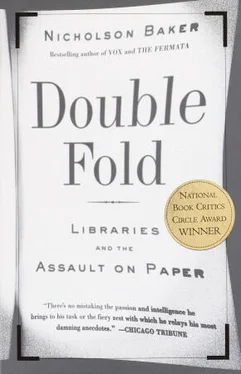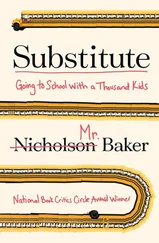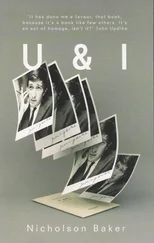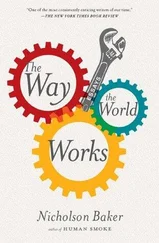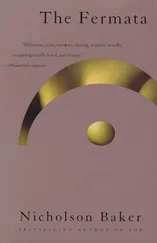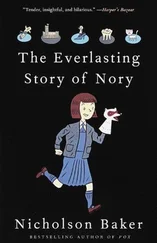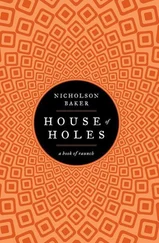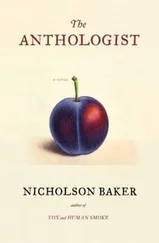Few microfilm copies of old newspapers are complete, either — not necessarily because the microfilmers skipped pages by mistake (although they have certainly been known to do that) but because the original run lacked issues or had items razored out of it by maniacal collectors. But in a marvelous bit of redefinitional insanity, a microfilmed newspaper is “considered complete” by the Library of Congress (according to its Newspapers in Microform 5 reference volumes) if “only a few issues per month are missing.” Taking “a few” to mean “two” (conservatively), a microfilm is all there, for the Library of Congress’s purposes, even when more than six percent of it isn’t there. If collection managers in major research libraries replace their own imperfect, even badly broken original runs of a given daily paper with copies of a single filmed set that, though known to be incomplete, is “considered complete” by indexers, and believed to be complete by trusting buyers, the replacement process necessarily leaves permanent, unfixable impairments in the documentary record. Before we had four different Ace combs in our pocket, each with a different missing tooth; now we have four miniature photographs of the same Ace comb with the same missing tooth. If that tooth happens to contain an article about the building of the new gymnasium in the high school where your parents met, or about the trolley-car line that once went down your street, forget it, you’re out of luck.
How does the Ace-comb syndrome affect historical research? Some years ago, David Bosse, 6who is now the librarian at the Historic Deerfield Library in Massachusetts, was compiling an annotated list of maps published in northern newspapers during the Civil War, when he found that the microfilm for some of the Chicago papers had “significant gaps” 7—gaps that couldn’t be filled, because there was no surviving original paper for that period. Worse, he discovered a six-month void in the filmed record of the New York Sun for 1862. (The Sun is one of the great New York dailies; in a later era it published Don Marquis’s “Archy and Mehitabel” columns.) “What I discovered was that everyone that I contacted had purchased the film from the New York Public Library,” Bosse said. “Some of them, I think, probably had runs of originals, decided to get rid of them, and replaced them with the New York Public Library film — and there was a six-month gap in the film.” Bosse was unable to locate any extant originals of the Sun that could supplement what the film lacked. “My own experience is that information does perish through this process,” he said.
Lucy Caswell, of the Cartoon Research Library at Ohio State, was working on a study of one of the first women political cartoonists, Edwina Dumm, 8who drew for the Columbus Monitor in the teens. Caswell had a scrapbook of original cartoons cut out of the paper, which Dumm had given her before she died, but they lacked dates and surrounding news. Using the microfilm of the Columbus Monitor, she was able to locate some of the cartoons, but some of them weren’t to be found, as a result of either missing issues or editional variation. Caswell tried to locate an original set of the paper, but there isn’t one: the copy in Columbus was destroyed after microfilming, and the Ohio Historical Society’s copy was given or sold to a man in Detroit who cut it up for the circus ads and threw the rest away.
I asked Caswell what she thought, given this sort of difficulty, about the prudence of keeping originals. “You’re talking to somebody who values the object, so I would always keep the paper master,” she said. “I know my cohorts in the past have not.” Caswell is diplomatic, as I’m not, about the losses: “I think that people did it in good conscience under circumstances that in some cases were beyond their control. Boards of trustees and administrators were saying, ‘You have to do this, we can’t afford to do otherwise.’ ” She senses a change of outlook, though. “It seems to me that maybe, for lots of reasons, our collective consciousness about history is getting a little better, and maybe we won’t repeat the errors we’ve made in the past.”
CHAPTER 6. Virgin Mummies
Ah, but we will almost certainly repeat some of the errors we made in the past. They keep coming back around, the counterfeit justifications, the false economies. The truth is that certain purificationally destructive transformations of old things into new things seem to excite people — otherwise polite, educated, law-abiding people — and it’s up to other normally polite people to try to stop them. I arrived at this conclusion late one night at the kitchen table, as I read through a Ph.D. dissertation from 1995 by a man named William Richard Lemberg, who directs the library at Saint Mary’s University in Minnesota. Lemberg’s webpage picture shows him with a push-broom mustache and a cheerfully bald forehead; he is a robe-wearing member of a Catholic order, the Brothers of the Christian Schools. To judge from our phone conversation, he is a gentle, genial man.
Brother Lemberg’s idea, supported by pages of statistical analysis and marvelously detailed cost assumptions, is that American libraries would collectively save a whole lot of money — about forty-four billion dollars over the next one hundred years, in fact — if they digitally scanned about twenty million books and got rid of more than four hundred million duplicates. Our libraries would be better off, in other words, if they destroyed about ninety-five percent of their accumulated collections. Brother Lemberg writes that “information professionals have begun to doubt the usefulness of paper-based technology as a long-term foundation for providing cost-effective information services.” The miniaturization of the newspapers was only a beginning.
The estimates and calculations in Lemberg’s work reminded me, as I looked over them, of a proposal by an enterprising nineteenth-century geologist named Dr. Isaiah Deck. 1Like Brother Lemberg, Dr. Deck was interested in the future of paper-based technology. He was English by birth; sometime before 1854, he came to the United States and set up an office at 113 Nassau Street 2in Manhattan, in the building where Vanity Fair had its offices, and where The New York Times was founded in 1851. Just down the street were other big-circulation newspapers: James Gordon Bennett’s New York Herald, Moses Beach’s Sun, and Horace Greeley’s New York Tribune. Their high-volume cylinder presses, built by Richard Hoe and Company, demanded an enormous volume of paper every day; according to an estimate made in 1856, it would have taken a caravan of six thousand wagons, 3each bearing two tons of paper, to carry the newsprint consumed in one year by the newspapers of New York City. In 1855, as the price of paper rose, Dr. Deck proposed to dig up two and a half million tons of Egyptian mummies, ship them to New York, unroll them, and use their linen wrappings to make paper.
It was all rag paper then, remember. Mill women sorted 4towering mounds and bales of linen and cotton castoffs, cutting the cloth by hand into four-inch squares 5or sending it through a cutting machine 6invented by Moses Beach of the Sun. (Moses’s son Alfred Beach, incidentally, edited Scientific American and invented the subway tunnel-boring machine.) The rags went into a tumbling drum, to rid them of dirt and buttons (rubber was almost impossible to remove completely, and left black specks 7in the paper), and they were boiled in chemicals to soften the cloth, and then they went into a rotary engine called — because it was invented by the Dutch — a Hollander. The Hollander, an oval trough with a metal-edged paddle wheel in it, tore and mashed the broth of half-digested rags until their cellulose fibers won independence, and this pulp, poured out onto a wire-mesh (or “web”) conveyor belt and squeezed through rollers, dried into paper — book paper and newsprint.
Читать дальше
